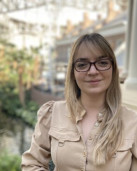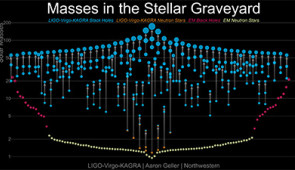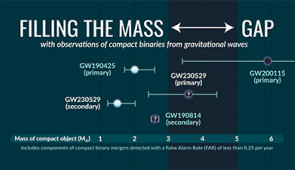
First gravitational-wave detection of a mass-gap object merging with a neutron star
The ‘mass gap’ might be ‘less empty than previously thought,’ researcher says
- Link to: Northwestern Now Story
EMBARGOED UNTIL 1 P.M. EDT (U.S.) ON FRIDAY, APRIL 5, 2024
- LIGO-Virgo-KAGRA Collaboration detected an unexpected signal at start of fourth observing run
- Merger includes a mystery object that is heavier than a neutron star but lighter than black holes observed in the Milky Way
- Scientists infer that the mystery object is most likely a low-mass black hole
EVANSTON, Ill. — An international research collaboration, including Northwestern University astrophysicists, has detected the first gravitational-wave signal from a merger between a potential neutron star and a mystery object in the “mass gap” — the range that lies between the heaviest known neutron star and the lightest known black hole.
The gravitational-wave signal alone cannot reveal the nature of the enigmatic object, which is 2.5 to 4.5 times the mass of our sun and located 650 million light-years from Earth. Future detections of similar events — especially those accompanied by bursts of electromagnetic radiation — could hold the key to solving this cosmic mystery.
“While previous evidence for mass-gap objects has been reported both in gravitational and electromagnetic waves, this system is especially exciting because it’s the first gravitational-wave detection of a mass-gap object paired with a neutron star,” said Northwestern’s Sylvia Biscoveanu, who managed the scientific paper and contributed to the analysis. “The observation of this system has important implications for both theories of binary evolution and electromagnetic counterparts to compact-object mergers.”
Access a copy of the study's manuscript here.
Biscoveanu is a NASA Einstein Fellow at Northwestern’s Center for Interdisciplinary Exploration and Research in Astrophysics (CIERA), where she works with CIERA director and leading LIGO Scientific Collaboration astrophysicist Vicky Kalogera. Kalogera, the Daniel I. Linzer Distinguished University Professor of Physics and Astronomy at Northwestern’s Weinberg College of Arts and Sciences, was a member of the science case study team. Michael Zevin, a CIERA visiting scholar and astrophysicist at the Adler Planetarium, chaired the editorial team for the discovery paper and the science case study team.
The LIGO-Virgo-KAGRA collaboration detected the signal from GW230529 in May 2023, shortly after the start of its fourth observing run. By analyzing the signal, astrophysicists determined it came from the merger of two compact objects: One with a mass between 1.2 to 2.0 times the mass of our sun and the other with a mass between 2.5 to 4.5 times the mass of our sun. The researchers say the less massive object likely is a neutron star and the more massive object is potentially a black hole. But scientists are confident the more massive object is within the mass gap.
Gravitational-wave observations now have provided nearly 200 measurements of compact-object masses. Of these, only one other merger most likely involved a mass-gap compact object. The signal GW190814 came from the merger of a black hole with a compact object exceeding the mass of the heaviest known neutron stars, possibly residing within the mass gap.
“Before we started observing the universe in gravitational waves, the properties of compact objects like black holes and neutron stars were indirectly inferred from electromagnetic observations of systems in our Milky Way,” Zevin said. “The idea of a gap between neutron-star and black-hole masses, an idea that has been around for a quarter of a century, was driven by such electromagnetic observations. GW230529 is an exciting discovery because it hints at this ‘mass gap’ being less empty than astronomers previously thought, which has implications for the supernova explosions that form compact objects and for the potential light shows that ensue when a black hole rips apart a neutron star.”
After a pause for maintenance, the fourth observing run will resume on April 10, 2024, with the LIGO Hanford, LIGO Livingston and Virgo detectors operating together. The KAGRA detector will join later in the run. The run will continue until February 2025 with no further planned breaks. LIGO-Virgo-KAGRA researchers are analyzing the data from the first half of the run and checking the remaining 80 significant signal candidates that have already been identified.
Gravitational-wave observatories
LIGO is funded by the National Science Foundation (NSF) and operated by the California Institute of Technology and Massachusetts Institute of Technology, which conceived and built the project. Financial support for the Advanced LIGO project was led by NSF with Germany (Max Planck Society), the U.K. (Science and Technology Facilities Council) and Australia (Australian Research Council) making significant commitments and contributions to the project. More than 1,600 scientists from around the world participate in the effort through the LIGO Scientific Collaboration, which includes the GEO Collaboration. Additional partners are listed at https://my.ligo.org/census.php.
The Virgo Collaboration is currently composed of approximately 880 members from 152 institutions in 17 different (mainly European) countries. The European Gravitational Observatory (EGO) hosts the Virgo detector near Pisa in Italy and is funded by Centre National de la Recherche Scientifique in France, the Istituto Nazionale di Fisica Nucleare in Italy and the National Institute for Subatomic Physics (Nikhef) in the Netherlands. A list of the Virgo Collaboration groups can be found at: https://www.virgo-gw.eu/about/scientific-collaboration/. More information is available on the Virgo website at https://www.virgo-gw.eu.
KAGRA is the laser interferometer with 3 km arm-length in Kamioka, Gifu, Japan. The host institute is Institute for Cosmic Ray Research at the University of Tokyo, and the project is co-hosted by National Astronomical Observatory of Japan and High Energy Accelerator Research Organization. KAGRA collaboration comprises more than 400 members from 128 institutes in 17 countries/regions. KAGRA’s information for general audiences is at the website https://gwcenter.icrr.u-tokyo.ac.jp/en/. Resources for researchers are accessible from http://gwwiki.icrr.u-tokyo.ac.jp/JGWwiki/KAGRA.
Multimedia Downloads
Infographics
Interview the Experts


Michael Zevin
Chair, editorial team and science case study team
Visiting scholar
Michael Zevin was a graduate student at CIERA from 2014-2020, and is now an astrophysicist at the Adler Planetarium.

Vicky Kalogera
Member, science case study team
Daniel I Linzer Distinguished University Professor of Physics and Astronomy
Director of Center of Interdisciplinary Exploration and Research in Astrophysics (CIERA)
Professor Kalogera is a leading astrophysicist with the LIGO Scientific Collaboration.

